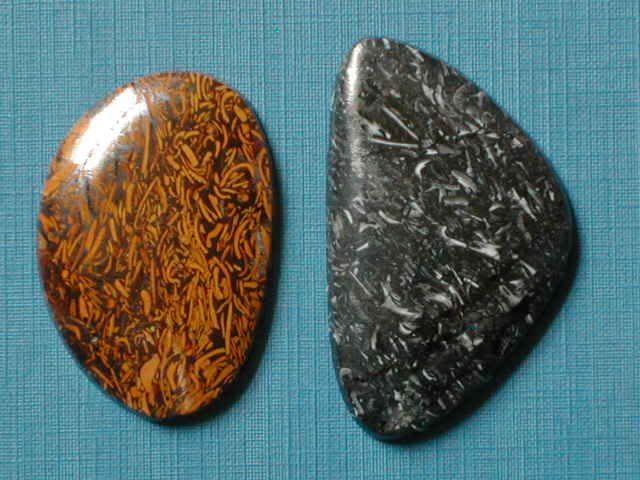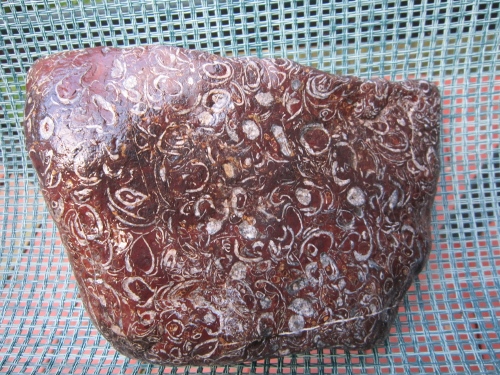Deleted
Deleted Member
Member since January 1970
Posts: 0
|
Post by Deleted on May 21, 2017 19:28:22 GMT -5
The rock of little shells. Recently Tommy and Sabre52 had a discussion about this stone. I'm so lucky I caught it (the discussion, not an infection). Thanks Mel for saying how to find it. I had business 20 minutes from the spot today. So I took a side trip and put some in my Hyundai. Not my normal rockhounding vehicle, but the passenger side floor did the trick! Here is first slice. May go back for more. AzRockGeekrockjunquiejeannieGarage RockertxrockhunteraDave1davezarguy |
|
Deleted
Deleted Member
Member since January 1970
Posts: 0
|
Post by Deleted on May 21, 2017 19:29:27 GMT -5
Sorry for the glare. It's oily!
I likey!!
|
|
|
|
Post by rockjunquie on May 21, 2017 19:34:59 GMT -5
That's the devil's toenails, right? It has a bunch of names, but that's the one I remember. Cool looking!
|
|
Deleted
Deleted Member
Member since January 1970
Posts: 0
|
Post by Deleted on May 21, 2017 19:38:21 GMT -5
Yes Tela, I believe that is one name for this form of stone. I think metalsmith had other names also. Chas? Here are two more pics. One of the nodule and the other a detail closeup. This stuff seems hard. Sorry, no testing yet. Lol   |
|
|
|
Post by rockjunquie on May 21, 2017 19:39:20 GMT -5
Bet that polishes up pretty with some nice contrast, too.
|
|
Deleted
Deleted Member
Member since January 1970
Posts: 0
|
Post by Deleted on May 21, 2017 19:51:09 GMT -5
I'm slabbing now. Will give jeannie first dibs. Then I may send samples to my friends...  |
|
Deleted
Deleted Member
Member since January 1970
Posts: 0
|
Post by Deleted on May 21, 2017 19:52:25 GMT -5
The more I look, the less I think shells and see crinoids. No?
|
|
Tommy
Administrator 
Member since January 2013
Posts: 12,991
|
Post by Tommy on May 21, 2017 19:56:14 GMT -5
That's neat looking stuff! Nice find.
|
|
Sabre52
Cave Dweller  Me and my gal, Rosie
Me and my gal, Rosie
Member since August 2005
Posts: 20,504
|
Post by Sabre52 on May 21, 2017 20:10:57 GMT -5
That's a nice one Scott. Glad you had good luck finding some! Technically, since those are tiny clams, Coquina is usually the ID term used but it is also sometimes called Pt. Mugu Shell Rock. Devil's Toenails is more correctly applied to the Texas fossil rock that contains little Oyster fossils by that name. The California stuff is variable in hardness but the better pieces take a pretty good polish. Here's a cab of the CA Coquina vs the similar Indian stuff. No crinoids, rocks wrong age, much younger. That's just the way your saw hit the various clams. There are gastropods present in some too.  Devil's Toenails with the little Grypha type oysters  |
|
|
|
Post by aDave on May 21, 2017 20:34:27 GMT -5
@shotgunner Scott, great stuff. Reminds me of what we cut at your place. I haven't had a chance to do anything with mine yet. Thanks for the tag. Where was this? Let me know when you want to go again. I'd like to join you.
Dave
|
|
Deleted
Deleted Member
Member since January 1970
Posts: 0
|
Post by Deleted on May 21, 2017 20:36:35 GMT -5
aDaveNot far from Turner's outdoorsman in oxnard
|
|
|
|
Post by aDave on May 21, 2017 20:40:45 GMT -5
aDave Not far from Turner's outdoorsman in oxnard. Definitely in my neck of the woods. Let me know when you'd like to head out there next. Turner's, just for reference, is about 20-25 minutes from home. Dave |
|
metalsmith
Cave Dweller 
Member since October 2012
Posts: 1,537
|
Post by metalsmith on May 21, 2017 22:35:04 GMT -5
Yes Tela, I believe that is one name for this form of stone. I think metalsmith had other names also. Chas? Here are two more pics. One of the nodule and the other a detail closeup. This stuff seems hard. Sorry, no testing yet. Lol Hi Scott, yes, please find a link to this this recent thread/postI also see Crinoids. These rocks are pretty typical of the Carboniferous Limestone that we find over here. In fact I noted some on the top of the mountain I ran recently (all the photos expand if you click them). Here in the England, the limestones can polish up quite well, but these fossils tend to be relatively soft and break easily unless they are found in chert nodules; they're generally kept as fossil samples. In the USA you seem to have many of our soft rocks infused with silica rocking the hardness up a step and making the rocks more resilient. ETA just a bit more regarding assemblages - I believe these are generically called fossil assemblages and can be classified (such is the nature of the human) into life assemblages or living assemblages and death assemblages. |
|
spiritstone
Cave Dweller 
Member since August 2014
Posts: 2,061 
|
Post by spiritstone on May 21, 2017 22:51:23 GMT -5
Widespread those little critters were. Found a creek full of them last summer very high up in the Rockies.  |
|
metalsmith
Cave Dweller 
Member since October 2012
Posts: 1,537
|
Post by metalsmith on May 22, 2017 8:39:06 GMT -5
Widespread those little critters were. Found a creek full of them last summer very high up in the Rockies.  Yes - hence bio-stratigraphy works so well at providing relative ages of rocks & we can correlate the various bands across the globe despite different thicknesses / depositional environments / matrix colour-chemistry etc! |
|
Deleted
Deleted Member
Member since January 1970
Posts: 0
|
Post by Deleted on May 22, 2017 10:22:37 GMT -5
@shotgunner Scott, great stuff. Reminds me of what we cut at your place. I haven't had a chance to do anything with mine yet. Thanks for the tag. Where was this? Let me know when you want to go again. I'd like to join you. Dave It's actually quite different than your piece at least from outside appearance. Maybe the tumbling of the waves did that. This is harder than steel. We will get ya some. |
|
Sabre52
Cave Dweller  Me and my gal, Rosie
Me and my gal, Rosie
Member since August 2005
Posts: 20,504
|
Post by Sabre52 on May 22, 2017 10:41:16 GMT -5
*sigh* Again, those deposits are not old enough to have crinoids. Primarily small clam shells and such. The formation that material comes from is Miocene in age, much newer rocks than those containing crinoids which mainly died out in one of the earlier mass extinctions. There are still a few living criniods but not likely to be in those shallow water clam beds, mainly free swimming or deep water critters.....Mel
|
|
metalsmith
Cave Dweller 
Member since October 2012
Posts: 1,537
|
Post by metalsmith on May 22, 2017 11:12:26 GMT -5
*sigh* Again, those deposits are not old enough to have crinoids. Primarily small clam shells and such. The formation that material comes from is Miocene in age, much newer rocks than those containing crinoids which mainly died out in one of the earlier mass extinctions. There are still a few living criniods but not likely to be in those shallow water clam beds, mainly free swimming or deep water critters.....Mel
The extant crinoid fauna of the tropical western Atlantic includes 23 genera/34 species of "stalkless" comatulid crinoids and eight genera/ten species of stalked crinoids. This is far greater than the known diversity of fossil crinoids from the Antillean region, which spans circa 120 Ma. The apparent rarity of fossil crinoids is probably part artefact, produced by collection bias, taphonomic effects, and the relative rarity of exposures of sedimentary units deposited in 150+ m <depth>.
In essence then, if the deposits represent that rare environment (but do they?) then there's every chance that they may contain crinoids. |
|
Deleted
Deleted Member
Member since January 1970
Posts: 0
|
Post by Deleted on May 22, 2017 11:15:42 GMT -5
Sabre52Would you help identify these features? Not just the big one, but at least three smaller ladder shaped ones. I can't see how they are bivalves.  Chas this isn't limestone. Steel won't scratch it. metalsmith
|
|
spiritstone
Cave Dweller 
Member since August 2014
Posts: 2,061 
|
Post by spiritstone on May 22, 2017 12:23:13 GMT -5
The Burgess shale fields are maybe less then an hour from where I found those plus clams and ferns, or could be the back bone of a fish? Looks like a fern to me  My understanding the area is around 505m years, the old Cambrian ecosystem. |
|